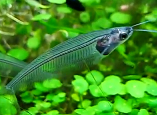 Glass Catfish
Glass Catfish is different from any other typical fish that you have seen, in the sense that you can actually see through to their internal body. It is sometimes synonymously called and referred to as a "
ghost catfish" because of its eerie appearance that shows the bone and stomach of the fish but however, both fishes are actually two different species which are closely related to each other. Glass catfish with its scientific name of
Kryptopterus bicirrhis differs from the ghost catfish (
Kryptopterus minor), in terms of size in which the bicirrhis are much bigger and have relatively longer anal fins. Since they belong to the catfish family (
Siluridae), both species also has a pair of barbel located close to their mouth.
Glass catfish is generally considered a friendly type of fish that can mix well with other non-aggressive tropical fish species and are compatible with the likes of tetras,
small-sized gourami, killifish and otocinclus. They usually prefer to move in groups and as such if you have intention to rare the fish, then you must consider buying at least 10 of them minimum. In fact, the higher the number actually turns out to be better because experts claims that the glass fish when kept in huge groups numbering at least 30 will create a healthy competition among themselves to compete for foods. If you are a first timer seeing them eat, you are bound to be amazed as you observe the foods that actually travels into the stomach of the fish and changes the color as it expands.
All glass catfish are very sensitive to changes in water quality. To get
healthy pet fish, temperature should be kept constant at around
26 degree Celsius without extreme fluctuations while in terms of nitrite and nitrate level, try to maintain and control it to the lowest level. Most of the time, if these water parameters were not closely monitored, the fish will fall sick and when it does, the transparent body will turn to white opaque color. Overall, in terms of behavior, the species is not the type of fish which are active swimmers. They spend most of their time staying idle close to the water plants with their heads turned upward. In fact, the tank that contains your pet glass catfish should also have clusters of aquatic plant to help the fish feel naturally at home. Plants are also beneficial in the sense that while they provide a sense of security for your fish, at the same time it also helps to reduce nitrate level to the minimum resulting in less harm to your glass catfish.
Your pet will readily accept any type of foods that you offer for them. Since they have a tiny mouth, you must ensure that the size of pellets and flakes can fit into it. Other than dried feeds, you can also enrich their diet with brine shrimps and bloodworms as they simply love them. Sometimes, it is good to leave patches of algae on the side of the tank and plant leaves so that they can also nibble on it. If well fed, glass catfish can grow up to
maximum 4 inches in length once it reaches adult age at around 15 months and normally the usual size will range from 3 inches and above.
 Glass Catfish is different from any other typical fish that you have seen, in the sense that you can actually see through to their internal body. It is sometimes synonymously called and referred to as a "ghost catfish" because of its eerie appearance that shows the bone and stomach of the fish but however, both fishes are actually two different species which are closely related to each other. Glass catfish with its scientific name of Kryptopterus bicirrhis differs from the ghost catfish (Kryptopterus minor), in terms of size in which the bicirrhis are much bigger and have relatively longer anal fins. Since they belong to the catfish family (Siluridae), both species also has a pair of barbel located close to their mouth.
Glass Catfish is different from any other typical fish that you have seen, in the sense that you can actually see through to their internal body. It is sometimes synonymously called and referred to as a "ghost catfish" because of its eerie appearance that shows the bone and stomach of the fish but however, both fishes are actually two different species which are closely related to each other. Glass catfish with its scientific name of Kryptopterus bicirrhis differs from the ghost catfish (Kryptopterus minor), in terms of size in which the bicirrhis are much bigger and have relatively longer anal fins. Since they belong to the catfish family (Siluridae), both species also has a pair of barbel located close to their mouth.







0 comments: